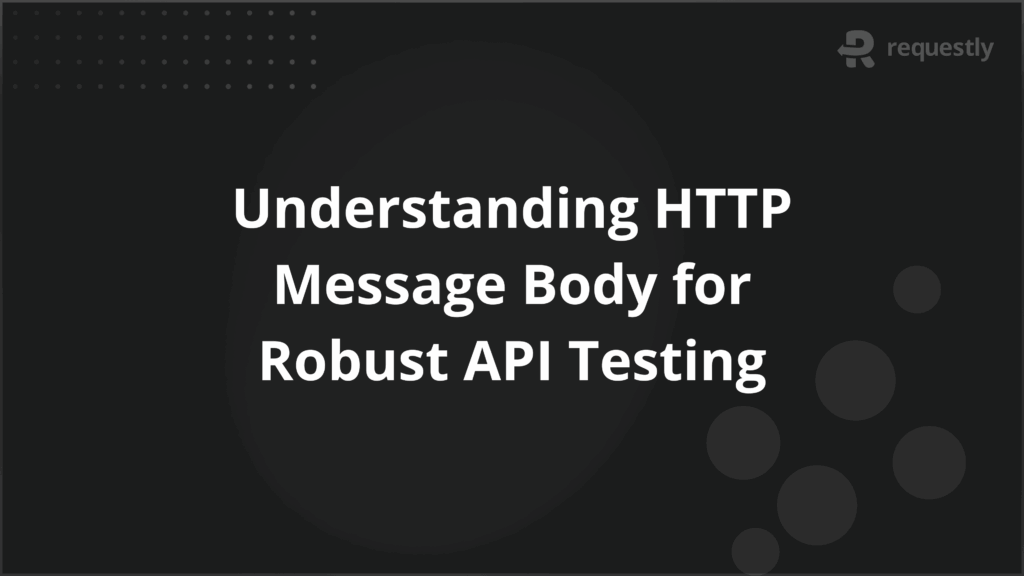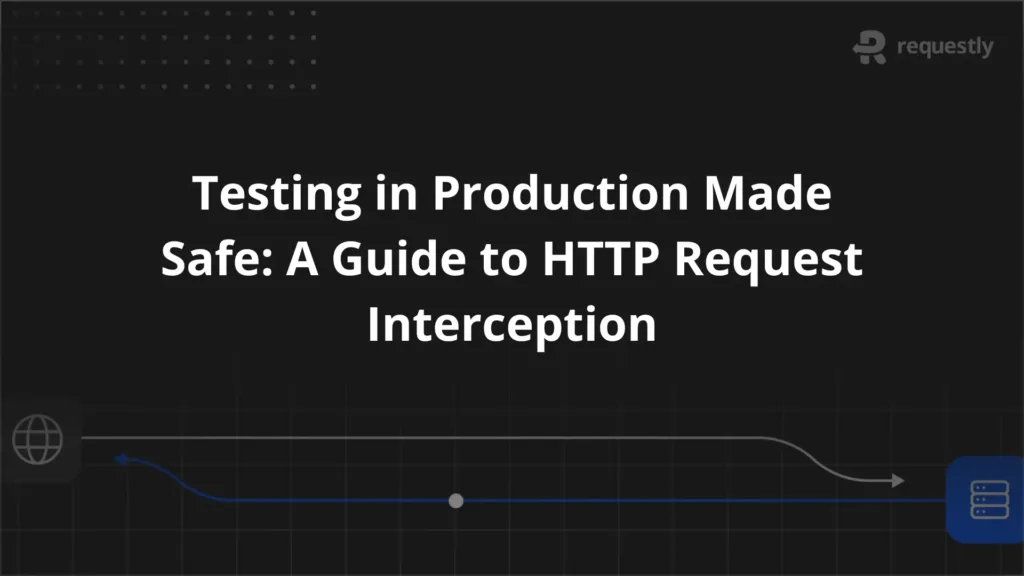Understanding HTTP Message Body for Robust API Testing


The HTTP message body contains the data that APIs exchange and is essential for validating requests, responses, and server behavior during testing. While headers provide metadata about requests or responses, the message body carries the actual content that applications process or store.
Testers use the HTTP message body to supply input data, trigger specific server logic, and validate that the API responds with the correct output under different conditions. Different HTTP methods, content types, and protocols handle message bodies in different ways.
This article provides a detailed understanding of HTTP message bodies, including their definition, purpose, structure, use with HTTP methods, and content types.
What is an HTTP Message Body?
The HTTP message body is the part of a request or response that carries the actual data between a client and a server. Headers provide information about the request or response. The message body contains the content that the server processes or the client receives. It can be plain text, JSON, XML, or binary, depending on what the API expects.
In requests, the message body sends input data for the server to act on. In responses, it delivers the output data that the client uses to display results or trigger other actions. Its format and size affect how the server handles the data and how the client reads it.
Here are the key points testers should focus on:
- Data Delivery: The body sends data to the server or receives data from it. For example, submitting a POST request with user details relies entirely on the message body.
- Format and Structure: The body can be text, JSON, XML, or binary. The format determines how the server reads and processes the data.
- Size and Limits: Servers may limit the body size. Large payloads can slow down processing or cause errors.
- Protocol Handling: HTTP/1.1, HTTP/2, and HTTP/3 handle the body differently. This affects how data is sent, compressed, or streamed.
- Validation Points: Testers can check the body for correct content, required fields, data types, and edge cases to ensure the API works as expected.
Why Use an HTTP Message Body?
The HTTP message body carries data between a client and a server. It allows APIs to perform actions based on client input and return structured responses.
Key reasons APIs use a message body include:
- Send Input Data: The body delivers data needed for server operations, such as login credentials, form submissions, or transaction details.
- Receive Output Data: The body contains server responses like user information, reports, or processed results. Testers can validate that the data matches expectations.
- Support Structured Data: Headers cannot carry large or complex data. The body handles JSON, XML, files, or binary content.
- Trigger Conditional Logic: Servers execute different actions depending on the payload. Testers can simulate multiple scenarios by modifying the body.
- Validate Data Integrity: Sending and receiving data through the body allows verification that APIs process inputs and outputs without corruption or loss.
- Enable Pagination and Filtering: APIs often require request bodies to define filters, search queries, or pagination rules.
- Facilitate Batch Operations: Multiple records or actions can be sent in a single request body, reducing network overhead.
- Test Error Handling: Sending invalid or malformed body content helps testers verify how the API responds to incorrect inputs.
Components of an HTTP Message
An HTTP message consists of two main parts: the headers and the message body. Each component has a specific role in how the client and server communicate. Let’s explore these key components of an HTTP message:
1. Start Line
The start line indicates whether the message is a request or a response. In requests, it includes the HTTP method, URI, and protocol version. In responses, it includes the protocol version, status code, and reason phrase. Testers use this line to confirm that the correct method and endpoint are being accessed and that the server responds with the expected status.
2. Headers
Headers carry metadata about the request or response. They include content type, content length, authentication information, caching instructions, and more. Headers guide the server in interpreting the message body and control how clients handle responses. Proper testing ensures that headers match expected values and that required headers are not missing.
3. Message Body
The body carries the main data payload. Its format and content depend on the API and HTTP method. For example, POST and PUT requests often include JSON data, while GET requests usually do not have a body. Testers focus on the body to validate that the data is sent and received correctly.
Use Cases of HTTP Methods and Message Body
Different HTTP methods interact with the message body in specific ways. Knowing these interactions helps testers craft requests accurately and verify server behavior. Each method has distinct purposes and rules for including a body.
Below are the common HTTP methods and their use cases with the message body:
- GET: GET requests usually do not include a message body. The request retrieves data from the server, and parameters are passed via the URL query string. Testers focus on verifying response data and status codes rather than sending a payload.
- POST: POST requests send data to the server to create new resources. The message body carries structured input like JSON, XML, or form data. Testers validate that the server processes the payload correctly, creates the resource, and returns the expected response.
- PUT: PUT requests update existing resources. The body contains the full representation of the resource. Testers check that the server overwrites or updates data accurately and that response codes reflect success or failure.
- PATCH: PATCH requests modify part of a resource. The body carries only the fields to update. Testers verify that partial updates are applied correctly without affecting unrelated fields.
- DELETE: DELETE requests typically do not include a body, but may in some implementations. The server uses the request to remove a resource. Testers confirm that the correct resource is deleted and that the response indicates success.
- OPTIONS: OPTIONS requests can include a body, but are primarily used to check server capabilities. Testers verify that the server returns supported methods and required headers.
- HEAD: HEAD requests do not include a body. They retrieve headers only to check resource existence or metadata. Testers confirm that headers match expectations without receiving the actual content.
Content Types in HTTP Message Body
The content type defines the format of the data in the HTTP message body. It tells the server how to interpret the incoming data and tells the client how to read the response.
Below are common content types and their testing considerations:
- application/json: JSON is widely used for APIs. Testers validate that JSON payloads are well-formed, contain required fields, and use correct data types. They also check server responses for properly structured JSON.
- application/xml: XML is often used in legacy systems or integrations. Testers verify that XML is correctly structured with proper tags and encoding, and that the server parses and returns valid XML.
- application/x-www-form-urlencoded: Common for HTML forms. Data is sent as key-value pairs. Testers ensure that form data is correctly encoded and that the server receives and processes all fields accurately.
- multipart/form-data: Used for file uploads or complex form data. Testers check that files and associated metadata are correctly transmitted and handled by the server.
- text/plain: Plain text payloads carry unstructured data. Testers validate that the server reads text content correctly and that any transformations or storage operations behave as expected.
- binary/octet-stream: For raw binary data. Testers ensure that files or binary streams are transmitted without corruption and that the server processes them correctly.
HTTP/2 and HTTP/3 Message Body Handling
HTTP/2 and HTTP/3 change how message bodies are transmitted and tested. Testers must focus on practical implementation to ensure APIs handle data correctly under these protocols.
Key implementation and testing points:
- Large Payload Handling: Chunked delivery allows sending large JSON files or binary data. Testers should verify that the server correctly assembles the payload and processes it without errors or timeouts.
- Concurrent Requests: Multiple requests share a single connection. Testers can send several requests simultaneously with different message bodies and confirm that each response corresponds to the correct request.
- Streaming Responses: APIs can send partial data in chunks. Testers must ensure that each chunk is received and processed in the correct order, for example, during large downloads or real-time feeds.
- Error Handling: Interrupted streams, incomplete payloads, or malformed chunks should be tested to confirm that the server detects issues and handles them gracefully.
- Protocol-Specific Validation: Body length and delivery timing differ from HTTP/1.1. Testers must account for frame-based delivery, potential reordering, and streaming behavior when validating responses.
- Tooling: Specialized HTTP/2 and HTTP/3 clients, scripts, or testing tools are required to send, receive, and verify chunked or streamed bodies accurately.
Common Issues with HTTP Message Body
Working with HTTP message bodies can introduce several challenges. Testers need to identify these issues to ensure APIs handle data correctly and maintain performance and security.
Below are common issues and what testers should check:
- Incorrect or Missing Data: Payloads may omit required fields or include invalid values. Testers should validate that the server rejects or handles these inputs appropriately.
- Malformed JSON or XML: Improper syntax can cause parsing errors. Testers should send malformed data and verify that the API responds with correct error messages or status codes.
- Mismatched Content Type: Sending a JSON payload with a text/plain header or vice versa can lead to server errors. Testers should confirm that content types align with the actual body format.
- Oversized Payloads: Large bodies may exceed server limits, causing timeouts or dropped connections. Testers should test boundary sizes and observe server behavior under high payload loads.
- Partial or Truncated Data: Network issues or protocol misconfigurations can result in incomplete message bodies. Testers should verify that servers detect partial payloads and respond properly.
- Encoding Issues: Character encoding mismatches can corrupt text data. Testers should check that UTF-8 or other specified encodings are correctly interpreted by both client and server.
Best Practices for Working with HTTP Message Body
Proper handling of HTTP message bodies is essential for accurate API testing, reliable server responses, and consistent data integrity. Below are best practices for handling message bodies:
- Validate Payload Structure: Always confirm that the message body matches the expected format. For example, JSON should have correct syntax, required fields, and proper data types.
- Check Content Types: Ensure that the Content-Type header reflects the actual format of the body. Mismatches can cause parsing errors or failed requests.
- Test Boundary Conditions: Include very large, empty, or minimal payloads to check server behavior and response handling.
- Simulate Partial or Streaming Data: For APIs that support chunked or streaming bodies, test incremental delivery and ensure the server assembles the data correctly.
- Monitor Response Codes: Verify that the server responds with correct HTTP status codes for both valid and invalid bodies.
- Include Negative Testing: Send malformed, incomplete, or unexpected payloads to ensure the API handles errors gracefully without exposing sensitive information.
- Use Encoding Consistently: Match character encoding in the body with server expectations to prevent data corruption, especially for text or multi-byte characters.
- Automate Tests: Use automated tools and scripts to send a variety of payloads, validate responses, and repeat tests efficiently across multiple endpoints.
- Document Test Cases: Clearly record the structure, expected results, and edge cases for each body type to maintain consistency and reproducibility.
Why Use Requestly for HTTP Message Body Management?
Managing HTTP message bodies during testing can be complex, especially when dealing with different formats, large payloads, or multiple API endpoints. Requestly provides tools to intercept, modify, and validate message bodies, making testing more precise and efficient.
Below are key ways Requestly supports message body management:
- Modify Requests and Responses: Testers can change payloads on the fly to simulate different scenarios without altering the server or client code.
- Validate API Behavior: By manipulating the message body, testers can verify that APIs respond correctly to different input data and edge cases.
- Simulate Partial or Streaming Data: Requestly allows sending modified or chunked payloads, enabling testing of APIs that handle streaming or large bodies.
- Automate Testing Workflows: Scripts and rules in Requestly can automate body modifications and validations across multiple endpoints, reducing manual effort.
- Support Multiple Content Types: Requestly allows modification and testing of JSON, XML, form data, and binary payloads to cover all common API scenarios.
- Error Injection: Testers can simulate invalid or malformed payloads to verify API error handling and response codes.
- Monitor and Log Changes: Requestly provides visibility into modified requests and responses, helping testers track changes and debug issues effectively.
Conclusion
Understanding the HTTP message body is critical for accurate API testing. It defines how data is sent and received, affects server behavior, and ensures clients get the correct responses. Testers who focus on payload structure, content types, and protocol-specific handling can design robust test cases and catch issues that impact functionality, performance, or security.
Requestly by BrowserStack makes this process easier by giving testers and developers direct control over the HTTP message body. It allows editing, mocking, and validating payloads across formats such as JSON, XML, and form data without changing the backend.

Contents
- What is an HTTP Message Body?
- Why Use an HTTP Message Body?
- Components of an HTTP Message
- 1. Start Line
- 2. Headers
- 3. Message Body
- Use Cases of HTTP Methods and Message Body
- Content Types in HTTP Message Body
- HTTP/2 and HTTP/3 Message Body Handling
- Common Issues with HTTP Message Body
- Best Practices for Working with HTTP Message Body
- Why Use Requestly for HTTP Message Body Management?
- Conclusion
Subscribe for latest updates
Share this article
Related posts






















